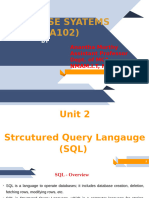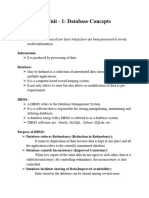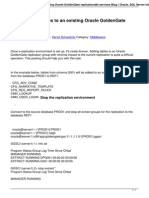SQL Notes (2) 2
Uploaded by
Harshit AgarwalSQL Notes (2) 2
Uploaded by
Harshit AgarwalCode itup A nan
Introduction To Database d
Sir
1. Database is an organized collection of Data. Here organized
means, the Data should be arranged in a particular order.
(i.e., It must be arranged).
2. If we have collection of Data, then only on the basis of
collection of Data we can’t say that is a database. We need to
organize this Data in a particular order.
3. Dictionary, Telephone Directory, Attendance Register, etc.
are the examples of Database in which all the
Words/Numbers/Names are stored in alphabetic order.
C odeManagement
Database Anan
itup System d
(DBMS)
Sir
1. It is a software to perform database activity. OR
2. It is an environment to perform database functionality. OR
3. DBMS is a way to achieve the database concept using
various IDE (Integrated Development Environment).
Advantages of Database
1. Since Database is an organized collection of Data, Data retrieval (Searching Data),
Updation, Deletion is very easier & Fast.
2. We can easily perform calculations on Data.
3. Data Security.
Code itup
Types Anand
of Database
Sir
There are following types of Databases :
1. Relational Database Management System (RDBMS).
SQL is a type of RDBMS in which data is stored in
rows and columns. i.e., in the form of table or tabular
form.
2. Hierarchical Database Management System (HDBMS).
3. Network Database Management System (NDBMS).
4. Object Oriented Database Management System (ODBMS).
We will go for SQL which is a type of RDBMS.
Codeitup Anand
To Create Database we have a lots of Database
Sir
Management System
(DBMS).
Note : Database is a collection of Tables
Examples : MySQL, SQL+, MS-Access, MongoDB, etc,.
DBMS
Table2 Table1
Database RDBMS HDBMS NDBMS ODBMS
Table4 Table3
SQL
ode
CSQL itup
(Structured Query nand
ALanguage)
Sir
SQL Stands for Structured Query Language. It is used for
creating Database. SQL adopts the concept of RDBMS
(Relational Database Management System). Relational
Database is a type of Database in which Data is stored in
the form of Rows & Columns. i.e., in a table or tabular
form.
Example :
Code itup
Structured Anan
Query Language (SQL) d
Database DBMS RDMS SQL
Relational Database Management System :
Sir
In RDBMS, data is stored in rows & columns i.e., in a table.
Columns OR Field OR Attributes
Table
Name :
Students Roll No. Name Gender Address Mobile No.
101 Amit Male Delhi 9897XXXXXX
Rows 102 Shivani Female Agra 8126XXXXXX
OR 103 Sanjay Male Mathura 9639XXXXXX
Tuples
Codeitup Anand
Terms In RDBMS
Sir
1. Table Relation.
2. Attribute.
Field/Column
3. Row/Tuple (Horizontal set of Information)
4. Columns/Field (Vertical set of Information)
5. Cardinality No. of Rows
6. Degree No. of Columns
7. Domain Pool of Values
Roll_No. Name Gender Address Mobile_No
101 Amit Male Delhi 9897XXXXX
Example :
Cardinality 3 X
102 Shivani Female Agra 8126XXXXX
Degree 5
itup
CodeSQL A
Commandsnan d
Sir
SQL is a collection of commands. For every task we have a
defined command which we have to use.
All the commands are divided into 3 Parts
1. DDL Commands (Data Definition Language)
2. DML Commands (Data Manipulation Language)
3. DCL/TCL Commands (Data/Transaction Control
Language)
Codeitup AnandDDL Commands (Data Definition Language)
Sir
DDL are the collection of all those commands which are used to create
Database structure and Related activities.
Examples : CREATE TABLE, ALTER TABLE, etc.
DML Commands (Data manipulation Language)
DML are the collection of all those commands which are used to
manipulate Data in the Database.
Examples : SELECT, INSERT, UPDATE, DELETE, etc.
TCL/DCL Commands (Transaction/Data Control Language)
TCL/DCL are the collection of those commands which are used to
control the Database transaction.
Examples : GRANT, REVOKE, etc.
itup
CodeData Types InA nand
SQL
Sir
1. char Store Character Value has fixed
length
2. varchar Store Character Value has variable
length
3. int or integer Stores Integer Value
4. decimal Stores Decimal Value.
5. date Stores Date.
6. time Stores Time.
Note : varchar is more suitable than char.
The Value of varchar & char Data Type are used in single
quotes.
Difference Between char &
varchar
char Fixed length (15)
Example : Name char
(15)
R A M _ _ _ _ _ _ _ _ _ _ _ _
varchar Variable length
Example : Name varchar
Codeitup Anand
Fill with white spaces
Release
Sir
(Not
Occupy)
R A M
Constraints In SQL
Constraints are set of rules that are applied to a
Table/Attribute/Field. There are following types of
Constraints :
1. Primary 4. Default
Key
5. Check
2. Unique
Key 6. Foreign Key
3. NOT
NULL
Codeitup Anand
Note : Candidate Key & Alternate Key These are not Constraints.
Sir
Candidate Key : Those who might be considered as primary key.
Alternate Key : A candidate key that is not primary key is called alternate key.
Codeitup Anand
1. Primary Key
Sir
Primary key is one which is unique and using this, the data is
uniquely identified. Primary Key constraints implies that the
attribute can not be duplicate value as well as it can not be left
blank. There are be only one Primary Key in one table.
Composite Key : When one single column/field is unable to uniquely
identify a
record, then two or more columns/fields are joined together to form
primary key but this time it is called Composite Key.
Primary Key = No duplicate values + It can’t be left blank.
OR
Primary Key = Unique Key + NOT NULL
Codeitup Anand
Table Name :
Studen
ts
Adm_No Name Gender Address Mobile_No
101 Amit Male Delhi 9897XXXXX
Sir
Primar
y
Key 102 Shivan Female Agra
X
8126XXXXX
i X
Can Sanjay Male Mathura 9639XXXXX
not X
be
101 Anjali Female Lucknow 7017XXXXX
Duplica
te
Value
Here Adm_No is Primary Key and hence it can’t contain
duplicate values as well as it can’t be left blank.
Codeitup Anand
Table Name :
Studen
ts
Adm_No Name Gender Address Mobile_No
101 Amit Male Delhi 9897XXXXX
Sir
Primar
y
Key 102 Shivan Female Agra
X
8126XXXXX
i X
103 Sanjay Male Mathura 9639XXXXX
X
104 Anjali Female Lucknow 7017XXXXX
Here Adm_No is Primary Key and hence it can’t contain
duplicate values as well as it can’t be left blank.
Codeitup Anand
2. Unique Key
Sir
Unique Key implies that an attribute can’t contain duplicate
values.
Uniqu
Roll_No Name Gender Address Mobile_No
101 Amit Male Delhi 9897XXXXX
e
X
Key
102 Shivani Female Agra 7017701770
Primar
103 Sanjay Male Mathura
y
104 Anjali Female Lucknow 7017701770
Key
105 Tarun Male Kanpur 8859XXXXX
Duplica
te
Here Mobile_No is Unique Key and henceit can’t
Value
contain duplicate but you can leave this blank.
Codeitup Anand
2. Unique Key
Sir
Unique Key implies that an attribute can’t contain duplicate
values.
Uniqu
Roll_No Name Gender Address Mobile_No
101 Amit Male Delhi 9897XXXXX
e
X
Key
102 Shivani Female Agra 7017701770
Primar
103 Sanjay Male Mathura
y
Key 104 Anjali Female Lucknow 8859885988
105 Tarun Male Kanpur 8859XXXXX
Left
Blan
Here Mobile_No is Unique Key and henceit can’t
contain duplicate but you can leave this blank.
Codeitup Anand
3. NOT NULL
Uniqu
e
Sir
This Implies that attribute can’t be left
blank.
NOT
NUL
L
Key
Primar Roll_No Name Gender Salary Mobile_No
y 101 Amit Male 50000 9897XXXXX
Key X
102 Shivani Female 60000 7017XXXXX
X
103 Pawan Male 55000 8888888888
be left
Here Name is NOT NULL and hence it can’t blank.
But it can contain duplicate values.
Can
not be
blank
Codeitup Anand
3. NOT NULL
Uniqu
e
Sir
This Implies that attribute can’t be left
blank.
NOT
NUL
L
Key
Primary Key Roll_No Name Gender Salary Mobile_No
101 Amit Male 50000 9897XXXXX
X
102 Shivani Female 60000 7017XXXXX
X
103 Pawan
Male 55000 8888888888
blank.
Here Name is NOT NULL and hence it can’t But it can
be left contain
duplicate values.
Duplica
te
Value
4. Default Anand
Codeitup
Sir
This implies that when any attribute is left blank, then it cab be
provided some default value which will be automatically inserted
when no values will be passed for that column.
Roll_No Name Salary Mobile_No Gender
101 Amit 50000 9897XXXXX M
X Default
102 Shivani 60000 7017XXXXX F ‘M’
X
103 Sanjay 55000 8879XXXXX
X
Taken Default
Value ‘M’
Here, Gender has a Default value ‘M’ then if no
values will be passed, it will automatically be filled with
‘M’.
5. Check Anand
Codeitup
Sir
This constraints check for a particular condition and if that condition
is TRUE, then only the value is inserted to the table otherwise
discarded.
Check
[Salary >
Roll No. Name Mobile No. Gender Salary
101 Amit 9897XXXXX M 50000
45000]
X
102 Shivani 7017XXXXX F 60000
X
103 Sanjay 8879XXXXX M 29000
X
104 Anjali 9368XXXXX F 52000
Error
X
Here, If Salary has a check constraints and it is checking that the salary must
not be less than 45,000, then if anyone will insert any value less than 45,000, it
will not accept that value and an error will be displayed.
Codeitup Anand
6. Foreign Key Minimum 2 Tables is required
Sir
When a filed in one table is playing the role of for Foreign Key (1st is Parent
Primary Key & the same field is a non-primary key in Table & 2nd is Child Table)
For this table
the anotherkey in the
table, another
then table is called
the non-primary
DepCode
is not primary key
AdmNo Name DepCode
101 Amit 1001
DepCode Name HOD
1001 Admin XYZ
Primar 102 Ajay 1002
y 1002 HR MNO
Key 103 Aman 1003 1003 Finance ABC
For this table DepCode is
primary key
In this table, the primary key is Code in this table, DepCode is Primary Key. So,
Here DepCode in
Admission Table is called Foreign Key.
Keyword to use foreign key is references OR Foreign key create a term Referential
Integrity.
Code itup
MySQL Anand
Commands
Sir
1. Create
Database
7. Alter
8. Update
2. Show
Database 9. Desc
3. Use 10. Select
4. Show Tables 11. Delete
5. Create Table 12. Drop
6. Insert Into
Code itup
1. CREATE Anand
DATABASE
Sir
This command is used to create a database.
Syntax :
MySQL> CREATE DATABASE DatabaseName;
Example :
MySQL> CREATE DATABASE students;
2. SHOW DATABASE
This command is used to display the list of all the database.
Syntax :
MySQL> SHOW DATABASES;
Code3.itup Anand
USE DATABASE
Sir
This command is used to open a database.
Syntax :
MySQL> USE DatabaseName;
Example :
MySQL> USE students;
4. SHOW TABLES
This command is used to show the table inside a database.
Syntax :
MySQL> SHOW TABLES;
Codeitup Anand
Remember : Before Create Table you know about the table
Sir
Structure. i.e., what you want to type of data & size of
field in table like.
TableName : students
Adm_No Name Mobile_No Address DOB Fees Gender
Integer varchar(30 char(10) varchar(100 date decimal char
) )
Note : If you does not use size of particular column then it takes default
range.
Note :
Decimal & Integer can not write in single quotes.
Char, Varchar & Date write in single quotes.
Write Date always in the format of YYYY-MM-DD.
Code5.itup Anand
CREATE TABLE
Sir
This command is used to create a table.
Syntax :
MySQL> CREATE TABLE Table_Name (
-> Col1 Datatype (Size) constrain
Optional
t,
-> Col2 Datatype (Size) constrain
t,
-> Col3 Datatype (Size) constrain
t,
______________
______________
-> );
Codeitup Anand Example :
Sir
MySQL> CREATE TABLE students (
-> Adm_No int primary key,
-> Name varchar (30) NOT NULL,
-> Mobile_No char (10),
-> Address varchar (100) NOT NULL,
-> DOB date,
-> Fees decimal check (Fees > 500),
-> Gender char default ‘M’
-> );
Default size is 1.
Codeitup Anand
TableName : students
Sir
Adm_No Name Mobile_No Addres DOB Fee
s s
Gende
r
Codeitup Anand
6. INSERT INTO
Sir
This command and is used to insert values in the table. We can insert
values in the table using 2 ways.
Syntax 1: For Every Column Value.
MySQL> INSERT INTO TableName values (
-> Val1, Val2, Val3, ……, Valn );
Example :
MySQL> INSERT INTO students values (
-> 101, ‘Ram’, 9897989798, ‘Delhi’, ‘2002-02-02’, 600, ‘M’);
Adm_No Name Mobile_No Address DOB Fees Gender
101 Ram 9897989798 Delhi 2002-02-02 600 M
Codeitup Anand
Syntax 2: For particular values of Column
Sir
MySQL> INSERT INTO TableName (Field1, Field2, …., Fieldn)
values
(Val1, Val2, ……, Valn);
Example :
MySQL> INSERT INTO students (Adm_No, Name, Adress, Fees,
Gender)
values (102, ‘Amit’, ‘Agra’, 900, ‘M’);
Adm_No Name Mobile_N Addres DOB Fees Gender
o s
101 Ram 9897989798 Delhi 2002-02-02 600 M
102 Amit Agra 900 M
Codeitup Anand Example :
Sir
MySQL> INSERT INTO students values (
-> 101, ‘Ram’, 9897989798, ‘Delhi’, ‘2002-02-02’, 600, ‘M’,
-> 102, ‘Amit’, 8126681266, ‘Agra’, ‘2004-04-20’, 900, ‘M’,
-> 103, ‘Sanju’, 8859885988, ‘Mathura’, ‘2003-07-12’, 550, ‘M’,
-> 104, ‘Satyam’, 9368936893, ‘Delhi’, ‘2005-01-13’, 700, ‘M’,
-> 105, ‘Pankaj’, 6395639563, ‘Agra’, ‘2007-06-15’, 850, ‘M’,
-> 106, ‘Versha’, 7017701770, ‘Mathura’, ‘2001-05-29’, 530, ‘F’,
-> 107, ‘Shivani’, 7907907907, ‘kanpur’, ‘2003-03-27’, 950, ‘F’,
-> 108, ‘Anjali’, 9557955795, ‘Bihar’, ‘2009-08-11’, 580, ‘F’,
-> );
Codeitup Anand TableName : students
Sir
Adm_No Name Mobile_No Address
101
102
Ram
Amit
9897989798 Delhi
8126681266 Agra
DOB
2002-02-02
2004-04-20
Fees Gender
600
900
M
M
103 Sanju 8859885988 Mathura 2003-07-12 550 M
104 Satyam 9368936893 Delhi 2005-01-13 700 M
105 Pankaj 6395639563 Agra 2007-06-15 850 M
106 Versha 7017701770 Mathura 2001-05-29 530 F
107 Shivani 7907907907 Kanpur 2003-03-27 950 F
108 Anjali 9557955795 Bihar 2009-08-11 580 F
7. Alter Anand
Codeitup
Sir
This command is used to make change in table structure.
1. To add a column Using ADD Keyword.
2. To delete a column Using DROP Keyword.
3. To rename a column Using RENAME Keyword.
4. To Modifying The Size or Datatype Using MODIFY
Keyword.
itup
CodeADD Column Anand
Sir
Syntax :
MySQL> ALTER TABLE Table_Name ADD FieldName datatype
(size);
Example :
MySQL> ALTER TABLE students ADD Address varchar (50);
DROP Column
Syntax :
MySQL> ALTER TABLE Table_Name DROP FieldName;
Example :
MySQL> ALTER TABLE students DROP DOB;
Anand
itupColumn
CodeRENAME
Sir
Syntax :
MySQL> ALTER TABLE TableName RENAME Column OldName to
NewName;
Example :
MySQL> ALTER TABLE students RENAME Column DOB to
Date_Of_Birth;
MODIFY Column
Syntax :
MySQL> ALTER TABLE TableName MODIFY FieldName Datatype
(size);
Example :
MySQL> ALTER TABLE students MODIFY Address varchar (50);
8. Update Anand
Codeitup Important
Sir
This command is used to update the pre-existing data in the table.
Syntax 1 : For Single Field
MySQL> UPDATE TableName set FieldName =where
Value
condition;
Example :
MySQL> UPDATE students set Address = ‘Gurgaon’ where
Name=‘Amit’;
If you does not used Use Primary Key
where then all the field Otherwise value fill
fill be that value with same type of
values.
Adm_No Name Mobile_N Addres DOB Fees Gender
o s
101 Ram 9897989798 Delhi 2002-02-02 600 M
102 Amit Gurgaon 900 M
Codeitup Anand
Syntax 2 : For Multiple Field
Sir
MySQL>
Field1 UPDATE
= Value, field2 = where condition;
Value,
TableName set Example :
SQL > Update students set Name=‘Rahul’, Fees=1000 where
Adm_No=102;
Adm_No Name Mobile_N Addres DOB Fees Gender
o s
101 Ram 9897989798 Delhi 2002-02-02 600 M
102 Rahul Gurgaon 1000 M
9. Desc
This command is used to show the structure of the Table.
Syntax : MySQL> DESC Table_Name;
Example : MySQL> DESC students;
10. Select Anand
Codeitup It shows
Sir
This command is used to extract data from all the
data of
the table. Syntax : MySQL> Select * from the table.
Table_Name; Example : MySQL> Select *
from students;
Select Particular Fields From The Table
Syntax :
MySQL> Select col1, col2, col3, … From Table_Name;
Example :
MySQL> Select Adm_No, Name, Gender from students;
Codeitup Anand Condition Based Searching
Sir
1. Where Clause : Where Clause is used to extract data from the table
with a given condition.
Syntax : MySQL> Select * From TableName Where Condition;
Example : MySQL> Select * From students Where Fees=550;
2. AND / OR : There may be some conditions where we need to
continue two or more conditions together. To combine the conditions
we use either AND or OR. AND : The conditions attached with AND will
give the result TRUE only when all the conditions are satisfied.
OR : Says that any one condition should be true and the result will be
TRUE.
Codeitup Anand
3. Distinct Clause : This Clause removes duplicate values from
Sir
the table. Syntax : MySQL> Select Distinct (Field) Fromwhere
TableName Example : MySQL> Select Distict (Address) Optional
From students;
4. Order By Clause : This clause is used to display the data in either
ascending order or in descending order. By default is sorts the data
in ascending order for sorting in descending order you may use
“Desc” at the end of the statement. Syntax : MySQL> Select * From
Ascending
Order
TableName Order By FieldName;
Example : MySQL> Select * From students Order By Name;
Syntax : MySQL> Select * From TableName Order By FieldName
Desc;
Example : MySQL> Select * From students Order By Name Desc;
Descending Order
Codeitup Anand
5. Between : This clause lets us the facility to give a range Here
Sir
of values. Including
Both
Syntax : Values
MySQL> Select * From TableName Where Condition Between Value1
And Value2;
Example : MySQL> Select * From students Where Fees Between 800
And 1000;
6. Membership Operator (In/Not In ) : This clause lets us the facility to look
for a set of values.
Syntax :
MySQL> Select * From TableName Where Column In (Value1,
Value2, …);
Example :
MySQL> Select * From students Where Address In (‘Agra’,
‘Mathura’);
Codeitup Anand
7. Pattern Matching (Like/Not Like) : Like clause is used for pattern
Sir
matching. In addition % and _ and helps in SQL for pattern matching
in SQL. Pattern matching refers to the extraction of data based on
string matching concepts.
% is used for multiple characters.
_ (underscore sign is used for representing single character. Once
underscore will represent one character, two underscore will represent
two character and so on.. Example :
MySQL> Select * From students Where Name Like ‘A%’;
MySQL> Select * From students Where Name Like ‘Am
%’; MySQL> Select * From students Where Name Like
‘A_ _ _’; MySQL> Select * From students Where Address
Like ‘%Colony%’;
11. Delete Anand
Codeitup
Sir
This command is used to Delete the data from the Table.
Syntax : MySQL> Delete From Table_Name Where Condition;
Example : MySQL> Delete From students Where gender=‘F’;
Syntax : MySQL> Delete From Table_Name; //Delete All Record Of
table
12. Drop
This command is used to Delete the data as well as the structure of the
Table.
Syntax : MySQL> Drop Table_Name;
Example : MySQL> Drop students;
The main difference between delete and drop command is that drop
command deletes the data as well as the structure of the table while
delete command deletes the data only.
Codeitup Anand SQL Functions
Sir
Single Row Functions Multiple Row
Functions (Aggregate
Functions)
String / Char
Functions
Numeric
Functions
Date & Time
Functions
itup
CodeMySQL Anand
Functions
Sir
Function : A function is a perform a predefine task.
String / Char Functions
1. Char : Return character of given ASCII
code. Syntax : MySQL> Select
char(Number); Example : MySQL>
Select char(65);
2. Concat : It concatenates two different strings.
Syntax : MySQL> Select concat(Val1, Val2, …);
Example : MySQL> Select concat(‘Name’, ‘Middle’, ‘Last’);
ASCII : American Standard Code for Information Interchange.
A : 65, B : 66, C : 67, … a : 98, b : 99, c : 100, …
Codeitup Anand
3. Lower / lcase : This function converts its argument in its lower case.
Sir
Syntax : MySQL> Select lower(‘Value’);
Example : MySQL> Select lower(‘RAM’); ra
m
4. Upper / ucase : This function converts its argument into upper case.
Syntax : MySQL> Select upper(‘Value’);
Example : MySQL> Select lower(‘ram’); RAM
5. Substr :
Syntax : MySQL> Select substr(‘String’, Position, No. of Characters);
Example 1: MySQL> Select substr(‘Jitendra’, 5, ndr
3);
Example 2: MySQL> Select substr(‘Jitendra’, -5, end
3);
Codeitup Anand
6. LTRIM : This function remove whitespaces from the beginning.
Syntax : MySQL> Select LTRIM(‘Value’);
Sir
Example : MySQL> Select LTRIM(‘ Jitendra 123’);
7. RTRIM : This function remove whitespaces from the last.
Jitendra 123
Syntax : MySQL> Select RTRIM(‘Value’);
Example : MySQL> Select RTRIM(‘123 Jitendra ’); 123
Jitendra
8. TRIM : This function remove whitespaces from the beginning as well as from the
end of
the string.
Syntax : MySQL> Select RTRIM(‘Value’);
Example : MySQL> Select RTRIM(‘ Jitendra ’); Jitendra
OR
‘_ _ _ _ _ _ _ _ _ _ Jitendra________________’
LEADING TRAINING
BOTH
Codeitup Anand
LEADING Syntax : MySQL> Select TRIM(LEADING ‘Val’ from ‘String’);
Sir
Example : MySQL> Select TRIM(LEADING ‘X’ from ‘XXXXJitendraX’);
JitendraX
TRAINING Syntax : MySQL> Select TRIM(TRAINING ‘Val’ from ‘String’);
Example : MySQL> Select TRIM(TRAINING ‘X’ from ‘XJitendraXXXX’);
XJitendra
BOTH Syntax : MySQL> Select TRIM(BOTH ‘Value’ from ‘String’);
Example : MySQL> Select TRIM(BOTH ‘X’ from ‘XXJitendraXXXX’);
Jitendra
9. INSTR : This function searches 2nd string in 1st string and returns its
index value if 2nd string is not found than returns 0.
Syntax : MySQL> Select INSTR(1st_String, 2nd_String);
Example : MySQL> Select INSTR(‘Jitendra’, ‘dra’); 6
Codeitup Anand
10. Length : This function returns the length of the given string.
Sir
Syntax : MySQL> Select Length(‘String’);
Example : MySQL> Select Length(‘Jitendra’); 8
11. Left : This function return given no. of characters from left side of the
string.
Syntax : MySQL> Select Left(‘String’, No. of Characters);
Example : MySQL> Select Left(‘Jitendra’, 4); Jeet
12. Right : This function return given no. of characters from right side of the
string.
Syntax : MySQL> Select Right(‘String’, No. of Characters);
Example : MySQL> Select Right(‘Jitendra Kumar’, 9); dra Kumar
13. Mid : This function return given no. of characters from given position in the
string.
Syntax : MySQL> Select Mid(‘String’, Position, No. of Characters);
Example : MySQL> Select Mid(‘Jitendra Kumar’, 5, 8); ndra Kum
Codeitup Anand Numeric Functions
Sir
1. MOD : This function divides 1st_No. with 2nd_No. and returns the
remainder.
Syntax : MySQL> Select MOD(1st_No.,
2nd_No.);
Example 1: MySQL> Select MOD(4, 2); 0
Example 2: MySQL> Select MOD(4, 0); 4
2. POWER / POW : This function return 2nd_No. raised to the power 1st_No.
Syntax : MySQL> Select Power(1st_No.,2nd_No.);
Example : MySQL> Select Power(2, 3); 23 = 8
3. Round : This function rounds of a given no. up to a given no. of digits.
Syntax : MySQL> Select Round(No., No. of Digits);
Example : MySQL> Select Round(152.7932, 1); 152.8
Codeitup Anand
Example 2 : MySQL> Select Round(157.8, -
1);
160
Sir
-1
-3
Nearest Ten’s
Nearest
Thousand’s
-2
-4
Nearest Hundred’s
Nearest Ten
Thousand’s
4. Truncate : This function truncates the given no. for given no. of
decimal places. Syntax : MySQL> Select Truncate(Given_No., Given
no. of decimal places);
MySQL> Example 1 :
Select 157.
Truncate(157.29, 1); 2
Example 2 :
MySQL> Select 157.
Example 3 : MySQL> Select Truncate(14.28, -1); 10
-1 Nearest Ten’s -2 Nearest Hundred’s
-3 Nearest Thousand’s -4 Nearest Ten Thousand’s
See the difference between Round &
Codeitup Anand
5. Sign : This function return the sign of given no.
Sir
1 Positive, -1 Negative, 0 Zero
Syntax : MySQL> Select
Sign(No.);
Example 1 : 1
MySQL> Select Sign(-30);
Example 2 : MySQL> Select Sign(10); -1
Example 3 : MySQL> Select Sign(0); 0
6. SQRT : This function returns the square root of given no.
Syntax : MySQL> Select
SQRT(No.);
Example 1 : MySQL> Select 5
SQRT(25);
Example 2 : MySQL> Select 5.47722557
SQRT(30); 5…
Codeitup Anand Date & Time Functions
Sir
1. CURDATE / Current_Date : This function returns current system
date. Syntax : MySQL> Select
Current_Date( ); YYYY-MM-
DD Que.) How to display the date after 10 days from current
date?
Ans.) MySQL> Select CURDATE( )+10;
2. Date : This function return the date from its expression.
Syntax : MySQL> Select date(FieldName) from TableName;
OR MySQL> Select date(‘2020-11-26 01:02:03’); 2020-11-26
3. Month : This function return month from the given date.
Syntax : MySQL> Select Month(Date);
Example : MySQL> Select Month(‘2020-11-26 01:02:03’); 11
Codeitup Anand
4. MonthName : This return name of the month from the given date.
Sir
Syntax : MySQL> Select MonthName(Date);
Example : MySQL> Select MonthName(‘2020-12-06 Decemb
01:02:03’); er
5. Day : This function return day from the given date.
Syntax : MySQL> Select Day(Date);
Example : MySQL> Select Day(‘2020-12-06 01:02:03’); 06
Que.) How to display only day of the today’s date.
Ans.) MySQL> Select Day(Curdate( )); Nested
Function
6. DayName : This function return the day in text like Sunday, Monday, …
etc.
Syntax : MySQL> Select Dayname(Date);
Example : MySQL> Select Dayname(‘2021-05-13’); Thursday
Codeitup Anand
7. Year : This function return year from given date.
Sir
Syntax : MySQL> Select Year(Date);
Example : MySQL> Select Year(‘2021-05- 202
13); 1
8. Now : This function return current date & time in the
format of YYYY-MM-DD HH:MM:SS
Syntax : MySQL> Select Now( ); 2021-05-13 02:05:36
9. Sysdate : This function return the system date & time in the
format of YYYY-MM-DD HH:MM:SS
Syntax : MySQL> Select Sysdate( ); 2021-05-13
02:05:36 Que.) What is difference between Now( ) & Sysdate( ) ?
Que.) What is the difference between Day( ) & DayOfMonth( ) ?
Codeitup Anand
10. DayOfYear : This function return Day of the given date.
Sir
Syntax : MySQL> Select DayOfYear(Date);
Example : MySQL> Select DayOfYear(‘2021-05-13 133
02:05:36);
11. DayOfMonth : This function return Day of the given date.
Syntax : MySQL> Select DayOfMonth(Date);
Example : MySQL> Select DayOfMonth(‘2021-05-13 13
02:05:36);
12. DayOfWeek : This function return week no. of given date.
Syntax : MySQL> Select DayOfWeek(Date);
Example : MySQL> Select DayOfWeek(‘2021-05-13 5
02:05:36);
1 Monday 2 Tuesday 3 Wednesd
ay
4 Thursday 5 Friday 6 Saturday
Code itup
Aggregate FunctionsA nand
MySQL
Sir
The function that operates on multiple rows at a time is called aggregate
functions.
1. AVG : This function return the average of its
argument. Syntax : MySQL> Select Avg(Field)
From TableName; Example : MySQL> Select
Avg(Field) From TableName;
2. SUM : This function return the sum of its
argument. Syntax : MySQL> Select Sum(Field)
From TableName; Example : MySQL> Select
Avg(Field) From TableName;
3. MAX : This function return the maximum value of its
argument. Syntax : MySQL> Select Max(Field) From
TableName; Example : MySQL> Select Max(Fees) From
students;
Codeitup Anand
4. MIN : This function return the minimum value of its
Sir
argument. Syntax : MySQL> Select Min(Field) From
TableName; Example : MySQL> Select Min(Fees) From
students;
5. COUNT : This function return the Total no. of rows OR Counting of
values in
given column (NOT NULL).
Syntax : MySQL> Select Count(*) From TableName;
Example : MySQL> Select Count(Name) From students;
Count the total number of values in particular column, If it is blank than it is not count.
Que.) Display the details of the student having maximum fees.
Ans.) MySQL> Select * From students where fees=(select max(fees) from
students );
Foreign KeyAnand
Codeitup
For this table DeptCode
Sir
It is a type of constraints (Set of Rules).
Table name : employee is not primary key
Code Name DeptCode
101 Amit 1001
Table Name : dept
Primar 102 Ajay 1002 DeptCode Name HOD
y 103 Aman 1003 1001 Admin XYZ
Key 1002 HR MNO
For this table DeptCode is primary key 1003 Finance ABC
In this table, the primary key is Code in this table, DepCode is Primary
Key. So, Here DeptCode in employee Table is called Foreign Key.
Keyword to use foreign key is references OR Foreign key create a term
Referential Integrity.
Syntax 1 : Create New Table & Foreign Key MySQL> Desc emp;
MySQL> Create Table dept ( Syntax 2 : Add Foreign
Key In Existing Table
-> DeptCode Integer primary
key,
-> NameOfDept varchar (50) NOT
NULL,
-> HOD varchar (50) NOT
NULL);
MySQL> Create Table employee (
-> Code Integer primary key,
-> Name varchar (50) NOT NULL,
-> Salary decimal,
-> DeptCodeInteger references
dept.DeptCode);
Codeitup Anand
Step 1 : Create
Sir
Table Which
have Primary
Key Keyword for use
Foreign Key
MySQL> Alter Table employee ADD Foreign Key (DeptCode) refrences
dept(DeptCode);
Join Anand
Codeitup
Sir
Join is a query. Joins are used to extract data from two or more tables.
There are different types of joins viz. Equi Join, Natural Join, Non-Equi
Join, Cartesian product, Cross Join and many more. But exam point of
view, Equi Join is most important.
Equi-join is a way to retrieve data from two or more table using (=)
equality operator. Note : When we want to extract data from 2 or more
tables it is only possible if one column is common in two tables. If you
don’t have proper column then you don’t extract data.
Codeitup Anand
Table name : employee
Example
Table Name : dept
Sir
Code Name DeptCode
101 Amit
102 Ajay
1001
1002
DeptCode Name
1001
1002
Admin
HR
HOD
XYZ
MNO
103 Aman 1003 1003 Finance ABC
Here employee
name alias as e
employee
MySQL> Select code, e.Name, DeptCode from dept where e.DeptCode=dept.DeptCode;
e,
MySQL> Select e.*, dept.* from employee e, dept where e.DeptCode=dept.DeptCode;
* Represents select all columns from table
Codeitup Anand
Table name : employee Table Name : dept
Sir
Code Name DeptCode DeptCode Name HOD
101 Amit 1001 1001 Admin XYZ
102 Ajay 1002 1002 HR MNO
Here DeptCode
column is
103 Aman 1003 1003 Finance ABC
common in both
tables
Types of Joins
Unrestricted Join Restricted Join
1. When we are joining 2 or more 1. When we are joining 2 or more
tables without any joining tables with a join condition.
condition 2. Proper Data is Retrieve.
2. Cartesian Product
Code itup
Cartesian Anan
Product (Cross Join) d
Sir
Table Name : a
Roll_No Name
1 Ajay
Table Name : b
Add
Agra
Contact_No.
123456 1
Cartesian Product of
table a and b.
Ajay Agra 123456
2 Sanjay Mathura 789123 1 Ajay Mathura 789123
3 Preeti Delhi 456789 1 Ajay Delhi 456789
2 Sanja Agra 123456
y
2 Sanja Mathura 789123
y
Syntax : MySQL> Select * From 2 Sanja Delhi 456789
a, b; y
3 Preeti Agra 123456
3 Preeti Mathura 789123
Codeitup Anand
Equi Join (=) : When joining is done using the equality operator.
Table Name : emp Table Name : dept
Sir
Code Name Salary deptcode
1 Ajay 12000 101
deptcode
101
Add Mobile
Agra 123456
2 Sanjay 15000 102 102 Mathura 789123
3 Preeti 11000 103 103 Delhi 456789
4 Anu 90000 102
MySQL> Select * From emp, dept where
emp.deptcode=dept.deptc
ode;
Code Name Salary deptcode deptcode Add Mobile
Output :
1 Ajay 12000 101 101 Agra 12345
6
2 Sanjay 15000 102 102 Mathura 78912 Equi Join
3
3 Preeti 11000 103 103 Delhi 45678
Codeitup Anand
Redency of Data : One Data show multiple times
Sir
Output :
Code Name Salary deptcode deptcode
1 Ajay 12000 101 101
Add Mobile
Agra 123456
2 Sanjay 15000 102 102 Mathura 789123
3 Preeti 11000 103 103 Delhi 456789
4 Anu 90000 102 102 Mathura 789123
Note : If you want fully qualified columns name i,.e, Do not show same
column multiple times.
MySQL> Select emp.*, dept.Add, dept.Mobile From emp, dept where
emp.deptcode=dept.deptcode Output
Codeitup Anand
Code Name Salary deptcode Add Mobile
Sir
1 Ajay 12000 101 Agra 123456
2 Sanja 15000 102 Mathura 789123
y
3 Preeti 11000 103 Delhi 456789
4 Anu 90000 102 Mathura 789123
MySQL> Select emp.*, dept.Add, dept.Mobile From emp, dept where
emp.deptcode=dept.deptcode AND emp.Salary>11000; Alias Table
Name
OR (If Table Name is too Large)
MySQL> Select e.code, e.Name, e.Salary, d.Add from emp e, dept d
where e.deptcode=d.deptcode AND e.Salary>11000;
Table Name
Codeitup Anand
Note : If a particular column name is same on both tables than in query
Sir
we write which column name is selected from table i.e., emp.Code
Otherwise if a particular column name is unique in both tables than
use only its name.
MySQL> Select Code, e.Add, Salary, Mobile from emp e, dept d
where e.deptcode=d.deptcode.
Equi Join (=)
MySQL> Select emp.*, dept.Mobile from emp, dept
where emp.deptcode=dept.deptcode;
Non-Equi Join (≠)
MySQL> Select emp.*, dept.Mobile from emp, dept where salary
Between 10000 AND 15000;
Codeitup Anand Cartesian
Sir
Product
1. MySQL> Select * From emp JOIN dept;
Equi Join
OR Condition
MySQL> Selct * From emp CROSS JOIN dept;
2. MYSQL> Select * From emp e JOIN dept d ON (e.deptcode=d.deptcode);
3. MySQL> Select * From emp NATURAL JOIN dept;
4. MySQL> Select e.Name, Salary From emp e where Common
Columns does
-> Salary Between 10000 AND 15000; not repeat
Non-Equi Join
Code Operation In A
Setitup nand
MySQL
Sir
UNION MINUS
A B
INTERESECT
Roll_No Name Age Roll_No Name Age
101 Aman 15 501 Kajal 25
102 Chama 17 103 Payal 21
n 502 Ghayal 18
103 Naman 21
Code Operation In A
Setitup nand
MySQL
Sir
1. UNION : Returns all the row from the tables and display the
duplicate data just once.
Syntax : MySQL> Select * From A UNION Select * From B;
2. INTERSECT : Returns the common row from the tables.
Syntax : MySQL> Select * From A INTERSECT Select * From B;
3. MINUS : It gives all the data from A deducting the
data from B. Syntax : MySQL> Select * From A MINUS
Select * From B; UNION ALL : Show all rows of both
tables either is same or not.
-----------------------------------Thanks For Studying-----------------------------------
You might also like
- Relational Database Management Systems-BasicNo ratings yetRelational Database Management Systems-Basic29 pages
- 12 Computer Science Notes CH06 Database and SQLNo ratings yet12 Computer Science Notes CH06 Database and SQL14 pages
- Structured Query Language (SQL) : By:-Amit Yerpude PGT (Computer Science) Kendriya Vidyalaya, KhagariaNo ratings yetStructured Query Language (SQL) : By:-Amit Yerpude PGT (Computer Science) Kendriya Vidyalaya, Khagaria94 pages
- Unit - 1 Database Concepts - RDBMS ToolsNo ratings yetUnit - 1 Database Concepts - RDBMS Tools8 pages
- DATABASE MANAGEMENT SYSTEM Notes For StudentsNo ratings yetDATABASE MANAGEMENT SYSTEM Notes For Students13 pages
- Class 12:DATABASES MANAGEMENT SYSTEM AND SQLNo ratings yetClass 12:DATABASES MANAGEMENT SYSTEM AND SQL9 pages
- 1ST ASSIGNMENT Implementation of DDL and DML Queries 1No ratings yet1ST ASSIGNMENT Implementation of DDL and DML Queries 13 pages
- Using Triggers To Add An Audit Log To Postgres DatabasesNo ratings yetUsing Triggers To Add An Audit Log To Postgres Databases13 pages
- What Are The Components of Physical Database Structure of Oracle Database100% (4)What Are The Components of Physical Database Structure of Oracle Database27 pages
- University of Technology Sydney SQL Summary Notes For SQL Test 2024No ratings yetUniversity of Technology Sydney SQL Summary Notes For SQL Test 20246 pages
- Deep Dive Faculty Enablement Program On Foundation Program 4.1 Anand Institute of Higher Technology, Kazhipattur, ChennaiNo ratings yetDeep Dive Faculty Enablement Program On Foundation Program 4.1 Anand Institute of Higher Technology, Kazhipattur, Chennai6 pages
- C2090-616.exam.37q: Website: VCE To PDF Converter: Facebook: TwitterNo ratings yetC2090-616.exam.37q: Website: VCE To PDF Converter: Facebook: Twitter20 pages
- Adding New Tables To An Existing Oracle Goldengate ReplicationNo ratings yetAdding New Tables To An Existing Oracle Goldengate Replication7 pages
- School of Computer Science and Engineering: Nosql Databases Slow Learner Performance Analysis ReportNo ratings yetSchool of Computer Science and Engineering: Nosql Databases Slow Learner Performance Analysis Report27 pages




















































































